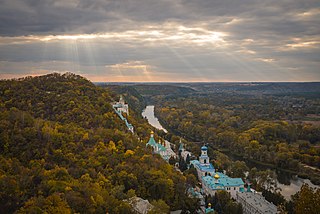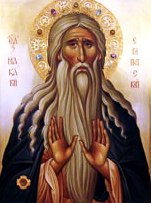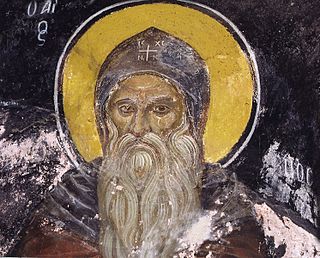Related Research Articles

Anthony the Great was a Christian monk from Egypt, revered since his death as a saint. He is distinguished from other saints named Anthony, such as Anthony of Padua, by various epithets: Anthony of Egypt, Anthony the Abbot, Anthony of the Desert, Anthony the Anchorite, Anthony the Hermit, and Anthony of Thebes. For his importance among the Desert Fathers and to all later Christian monasticism, he is also known as the Father of All Monks. His feast day is celebrated on 17 January among the Eastern Orthodox and Catholic churches and on Tobi 22 in the Coptic calendar.

Moses the Black, also known as Moses the Strong, Moses the Robber, and Moses the Ethiopian, was an ascetic monk and priest in Egypt in the fourth century AD, and a Desert Father. He is highly venerated in the Eastern Orthodox Church and the Oriental Orthodox Church. According to stories about him, he converted from a life of crime to one of asceticism. He is mentioned in Sozomen's Ecclesiastical History, written about 70 years after Moses's death.

A lavra or laura is a type of monastery consisting of a cluster of cells or caves for hermits, with a church and sometimes a refectory at the center. Lavra monasteries operate within the Orthodox and other Eastern Christian traditions; the name is also used by some Catholic communities. The term in Greek initially meant a narrow lane or an alley in a city.

Macarius of Egypt was a Christian monk and grazer hermit. He is also known as Macarius the Elder or Macarius the Great.

The Desert Fathers were early Christian hermits and ascetics, who lived primarily in the Scetes desert of the Roman province of Egypt, beginning around the third century AD. The Apophthegmata Patrum is a collection of the wisdom of some of the early desert monks and nuns, in print as Sayings of the Desert Fathers. The first Desert Father was Paul of Thebes, and the most well known was Anthony the Great, who moved to the desert in AD 270–271 and became known as both the father and founder of desert monasticism. By the time Anthony had died in AD 356, thousands of monks and nuns had been drawn to living in the desert following Anthony's example, leading his biographer, Athanasius of Alexandria, to write that "the desert had become a city." The Desert Fathers had a major influence on the development of Christianity.

Ammon, Amun, Ammonas, Amoun (Ἀμοῦν), or Ammonius the Hermit was a 4th-century Christian ascetic and the founder of one of the most celebrated monastic communities in Egypt. He was subsequently declared a saint. He was one of the most venerated ascetics of the Nitrian Desert, and Athanasius of Alexandria mentions him in his life of Anthony the Great.

Kellia, referred to as "the innermost desert", was a 4th-century Egyptian Christian monastic community spread out over many square kilometers in the Nitrian Desert about 65 km (40 mi) south of Alexandria. It was one of three centers of monastic activity in the region, along with Nitria and Scetis. It is called al-Muna in Arabic and was inhabited until the 9th century. Only archaeological sites remain there today.

A skete is a monastic community in Eastern Christianity that allows relative isolation for monks, but also allows for communal services and the safety of shared resources and protection. It is one of four types of early monastic orders, along with the eremitic, lavritic and coenobitic, that became popular during the early formation of the Christian Church.

Wadi El Natrun is a depression in northern Egypt that is located 23 m (75 ft) below sea level and 38 m (125 ft) below the Nile River level. The valley contains several alkaline lakes, natron-rich salt deposits, salt marshes and freshwater marshes.

The Monastery of Saint Macarius The Great also known as Dayr Aba Maqār is a Coptic Orthodox monastery located in Wadi El Natrun, Beheira Governorate, about 92 km (57 mi) north-west of Cairo, and off the highway between Cairo and Alexandria.

The Monastery of Saint Pishoy in Wadi El Natrun, Beheira Governorate, Egypt, is the most famous monastery of the Coptic Orthodox Church of Alexandria named after Pishoy. It is the easternmost of the four current monasteries of Wadi el Natrun.

Pambo was a Coptic Desert Father of the fourth century and disciple of Anthony the Great. His feast day is July 18 among the Oriental Orthodox, Eastern Orthodox, and Catholic churches.

Paromeos Monastery, also known as Baramos Monastery, is a Coptic Orthodox monastery located in Wadi El Natrun in the Nitrian Desert, Beheira Governorate, Egypt. It is the most northern among the four current monasteries of Scetis, situated around 9 km northeast of the Monastery of Saint Pishoy. Ecclesiastically, the monastery is dedicated to and named after the Virgin Mary.

The Monastery of Saint Mary El-Sourian is a Coptic Orthodox monastery located in Wadi El Natrun in the Nitrian Desert, Beheira Governorate, Egypt. It is located about 500 meters northwest of the Monastery of Saint Pishoy.
Palladius of Galatia or Palladius of Helenopolis was a Christian chronicler and the bishop of Helenopolis in Bithynia. He was a devoted disciple of Saint John Chrysostom. He is best remembered for his work, the Lausiac History. He was also the author of the Dialogue on the Life of Chrysostom. Palladius is a saint in the Coptic Orthodox Church and in the Syrian Orthodox Church, wherein he is given the honorific title, The Solitary. His feast day is November 29.

Coptic monasticism was a movement in the Coptic Orthodox Church to create a holy, separate class of person from layman Christians.
Nitria is one of the earliest Christian monastic sites in Egypt and is located in the Nitrian Desert. It was the first of the three major centers of Christian monastic activity in the Lower Egypt, the other two being Kellia and Scetis.
Ammonas of Egypt was an eastern Christian anchorite, monastic, and Desert Father who was born around the early 4th century. He is a saint in the Eastern Orthodox Church. Ammonas was a disciple of Anthony the Great and Pambo. Many of his known sayings and quotations exist in eleven sections of the Sayings of the Desert Fathers.
Christian monasticism first appeared in Egypt and Syria. This is a partial chronology of early Christian monasticism with its notable events listed. It covers 343 years.
Mount Colzim, also known as the Inner Mountain of Saint Anthony, is a mountain in Red Sea Governorate, Egypt. It was the final residency of Anthony the Great from about AD 311, when he was 62 years of age, to his death in 356.
References
- ↑ "Nitrian Desert", in F. L. Cross and E. A. Livingstone, eds., The Oxford Dictionary of the Christian Church, 3rd rev. ed. (Oxford University Press, 2005, online 2009).
- ↑ Janet Timbie, "Egypt", in William M. Johnston and Christopher Kleinhenz, eds., Encyclopedia of Monasticism (Routledge, 2015), pp. 432–435.
- ↑ Roger S. Bagnall and Dominic W. Rathbone, eds., Egypt from Alexander to the Early Christians: An Archaeological and Historical Guide (Getty Publications, 2004), pg. 108–115 (map on p. 109).